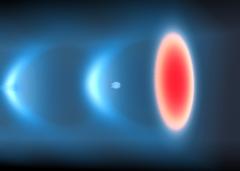URL: https://www.desy.de/news/news_search/index_eng.html
Breadcrumb Navigation
DESY News: New Concept for High Quality Plasma Accelerators
News
News from the DESY research centre
New Concept for High Quality Plasma Accelerators
DESY scientists have proposed a new concept for so-called plasma accelerators that could overcome some of the current limitations of this technology. These novel devices are currently in the spotlight due to their potential for significantly shrinking the size and cost of future accelerator facilities. However, this technology faces a number of issues that currently prevent plasma accelerators to be widely used for applications. The newly presented concept, published in the journal Physical Review Letters (PRL), addresses the energy spread, one of the most pressing challenges of this novel technology, and could enable applications such as compact free-electron lasers, measuring just dozens of meters instead of kilometres as today.

3D view of the plasma wakefields (blue) generated by a laser pulse (red) propagating from left to right. The accelerated electron beam can be seen in blue in the first accelerating bucket. Credit: DESY/Universität Hamburg, Angel Ferran Pousa
“What we propose in our concept is performing the acceleration process in two plasma stages which are then joined by an array of magnets known as chicane.” says Angel Ferran Pousa, a PhD student from University Hamburg at DESY and lead author of the study. “This chicane inverts the energy correlation along the beam and therefore allows it to be naturally compensated for in the second stage. As a result, the energy spread of the beam is drastically reduced.”

Overview of a conceptual implementation of the proposed scheme. The two plasma acceleration stages (blue) are joined by a magnetic chicane. Two active plasma lenses (red) are used for beam transport and plasma mirrors are used for the laser in- and outcoupling. The trajectory of the laser pulses and the electron beam is represented in red and white, respectively. Credit: DESY/Universität Hamburg, Angel Ferran Pousa
“This new concept of a low energy spread plasma accelerator and the underlying improved understanding of the relevant accelerator physics phenomena is the culmination of several years of work by a team of scientists. It could be a major step forward in building a plasma-based free-electron laser at multi-GeV beam energy but the validation of the concept requires experimental tests which could be partly carried out in the ATHENA project”, comments Ralph Assmann, EuPRAXIA coordinator and DESY leading scientist for accelerator research and development, in whose group this work was performed.
This work was supported by EU funding for the Horizon2020 Design Study EuPRAXIA and by the Helmholtz Association (via project IuVF ZT-0009).
Reference: Compact Multistage Plasma-Based Accelerator Design for Correlated Energy Spread Compensation, A. Ferran Pousa, A. Martinez de la Ossa, R. Brinkmann, and R. W. Assmann, Physical Review Letters, 2019; DOI: 10.1103/PhysRevLett.123.054801




